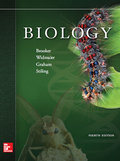
Concept explainers
The water necessary for photosynthesis
- a. is split into H2 and O2.
- b. is directly involved in the synthesis of carbohydrates.
- c. provides the electrons to replace those lost in photosystem II.
- d. provides the H + needed to synthesize G3P.
- e. does none of the above.
Introduction: The water molecule is essential in photosynthesis. It splits into hydrogen ions and oxygen, and provide electrons to replace the lost electrons from the photosystem II during the light reaction. This reaction is called photolysis of water. The protons can be used to produce ATP through ATP synthase.
Answer to Problem 1TY
Correct answer: The water present in the photosynthesis provides the electrons to replace the loss of electrons in the photosystem II. Hence, the correct answer is option c.
Explanation of Solution
Reason for correct answer:
Option c. is given as “provides the electrons to replace those lost in photosystem II”.
The photolysis of water provides electrons to replace the lost electrons in the photosystem II. It dissociates into hydrogen ions and oxygen. During this reaction, the electrons produced from the hydrogen ions are used to replace the electrons lost in the photosystem II. Hence, the correct answer is option c.
Reasons for the incorrect answer:
Option a. is given as “is split into H2 and O2”.
The water is split into oxygen and hydrogen ions and not hydrogen gas. This is because the electrons gained from the formation of hydrogen ions are provided to replace lost electrons in the photosystem II. Hence, option a. is incorrect.
Option b. is given as “is directly involved in the synthesis of carbohydrates”.
The water molecule is not directly involved in the synthesis of carbohydrates. It only provides electrons for the photosystem II. The molecule of carbon dioxide serves as the direct fuel for the production of carbohydrates. Hence, option b. is incorrect.
Option d. is given as “provides the H+ needed to synthesize G3P”.
Water provides electrons to the photosystem II. G3P is synthesized by the reduction and dephosphorylation of 1,3 biphosphoglycerate which is further coupled with the oxidation of NADH. Hence, option d. is incorrect.
Option e. is given as “does none of the above”.
Water does provide an electron to the reaction centre and it is used for the production of energy using light. It also splits into hydrogen ions and single oxygen atoms which then forms oxygen gas. The oxygen produced is liberated as the by-product of photosynthesis. Hence, option e. is incorrect.
Hence, the options a., b., d., and e. are incorrect.
Water dissociates into the single oxygen atom and hydrogen ions liberates electron. The released electron is captured by the photosystem II. The electron then passes to the primary electron acceptor and finally to the photosystem I. Photosystem I uses it to produce energy in the form of ATP and NADPH.
Want to see more full solutions like this?
Chapter 8 Solutions
EBK BIOLOGY
Additional Science Textbook Solutions
Biological Science (6th Edition)
Laboratory Manual For Human Anatomy & Physiology
Campbell Biology in Focus (2nd Edition)
General, Organic, and Biological Chemistry - 4th edition
SEELEY'S ANATOMY+PHYSIOLOGY
Biology: Life on Earth with Physiology (11th Edition)
- students in a science class investiged the conditions under which corn seeds would germinate most successfully. BAsed on the results which of these factors appears most important for successful corn seed germination.arrow_forwardI want to write the given physician orders in the kardex formarrow_forwardAmino Acid Coclow TABle 3' Gly Phe Leu (G) (F) (L) 3- Val (V) Arg (R) Ser (S) Ala (A) Lys (K) CAG G Glu Asp (E) (D) Ser (S) CCCAGUCAGUCAGUCAG 0204 C U A G C Asn (N) G 4 A AGU C GU (5) AC C UGA A G5 C CUGACUGACUGACUGAC Thr (T) Met (M) lle £€ (1) U 4 G Tyr Σε (Y) U Cys (C) C A G Trp (W) 3' U C A Leu בוט His Pro (P) ££ (H) Gin (Q) Arg 흐름 (R) (L) Start Stop 8. Transcription and Translation Practice: (Video 10-1 and 10-2) A. Below is the sense strand of a DNA gene. Using the sense strand, create the antisense DNA strand and label the 5' and 3' ends. B. Use the antisense strand that you create in part A as a template to create the mRNA transcript of the gene and label the 5' and 3' ends. C. Translate the mRNA you produced in part B into the polypeptide sequence making sure to follow all the rules of translation. 5'-AGCATGACTAATAGTTGTTGAGCTGTC-3' (sense strand) 4arrow_forward
- What is the structure and function of Eukaryotic cells, including their organelles? How are Eukaryotic cells different than Prokaryotic cells, in terms of evolution which form of the cell might have came first? How do Eukaryotic cells become malignant (cancerous)?arrow_forwardWhat are the roles of DNA and proteins inside of the cell? What are the building blocks or molecular components of the DNA and proteins? How are proteins produced within the cell? What connection is there between DNA, proteins, and the cell cycle? What is the relationship between DNA, proteins, and Cancer?arrow_forwardWhy cells go through various types of cell division and how eukaryotic cells control cell growth through the cell cycle control system?arrow_forward
 Biology (MindTap Course List)BiologyISBN:9781337392938Author:Eldra Solomon, Charles Martin, Diana W. Martin, Linda R. BergPublisher:Cengage Learning
Biology (MindTap Course List)BiologyISBN:9781337392938Author:Eldra Solomon, Charles Martin, Diana W. Martin, Linda R. BergPublisher:Cengage Learning
 Biology: The Dynamic Science (MindTap Course List)BiologyISBN:9781305389892Author:Peter J. Russell, Paul E. Hertz, Beverly McMillanPublisher:Cengage Learning
Biology: The Dynamic Science (MindTap Course List)BiologyISBN:9781305389892Author:Peter J. Russell, Paul E. Hertz, Beverly McMillanPublisher:Cengage Learning Concepts of BiologyBiologyISBN:9781938168116Author:Samantha Fowler, Rebecca Roush, James WisePublisher:OpenStax College
Concepts of BiologyBiologyISBN:9781938168116Author:Samantha Fowler, Rebecca Roush, James WisePublisher:OpenStax College Biology 2eBiologyISBN:9781947172517Author:Matthew Douglas, Jung Choi, Mary Ann ClarkPublisher:OpenStax
Biology 2eBiologyISBN:9781947172517Author:Matthew Douglas, Jung Choi, Mary Ann ClarkPublisher:OpenStax Biology Today and Tomorrow without Physiology (Mi...BiologyISBN:9781305117396Author:Cecie Starr, Christine Evers, Lisa StarrPublisher:Cengage Learning
Biology Today and Tomorrow without Physiology (Mi...BiologyISBN:9781305117396Author:Cecie Starr, Christine Evers, Lisa StarrPublisher:Cengage Learning





